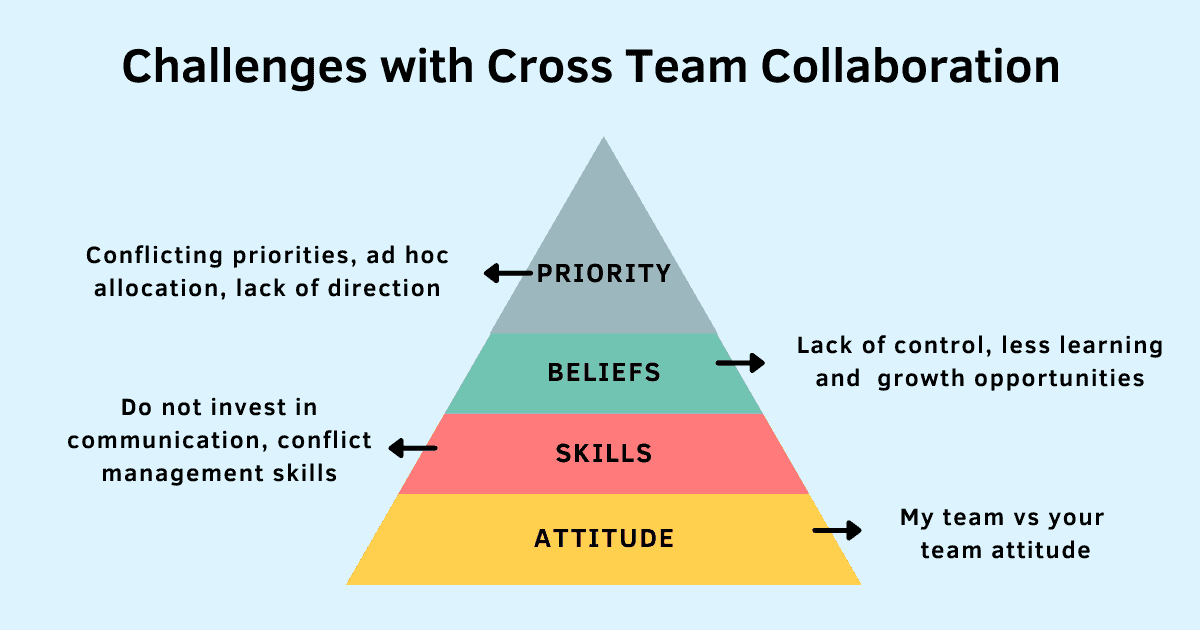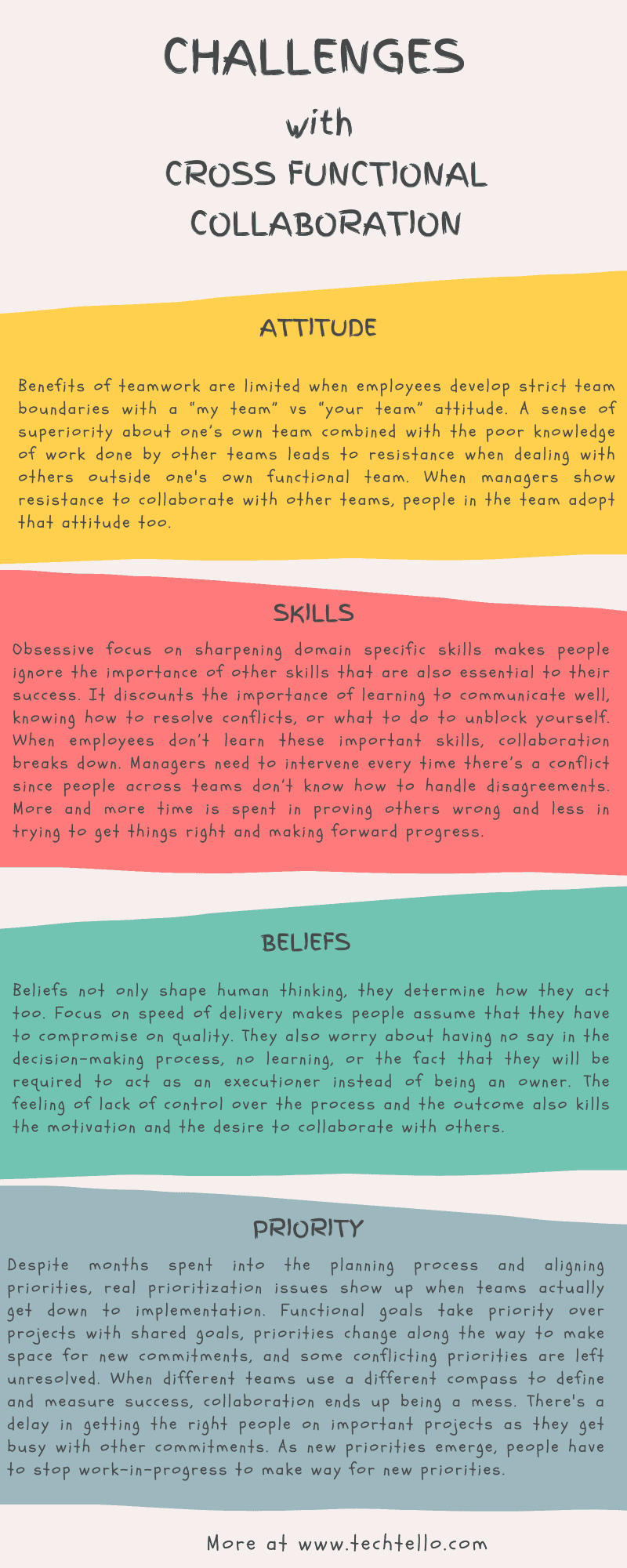Challenges With Cross Functional Collaboration and What to Do About It

In a fast-moving, ever-changing, dynamic work environment, the ability to collaborate effectively isn’t a necessity, it’s a superpower.
From working as a junior developer on a small product to leading large engineering teams to providing guidance in a leadership role, I had the opportunity to experience, observe and craft effective cross-team collaboration strategies.
Irrespective of where I worked or who I worked with, the same set of challenges surfaced over and over again. When collaborating across teams, communication, coordination, visibility, execution speed, and decision-making were always a mess.
These gaps while collaborating across teams boiled down to four broad issues:
1. Attitude
The concept of teamwork with its clear merits broke down when people were required to cross team boundaries. Even those who effectively collaborated with their own team members struggled to repeat those behaviors with people outside their teams.
Benefits of teamwork were limited as employees developed strict team boundaries with a “my team” vs “your team” attitude.
A sense of superiority about one’s own team combined with the poor knowledge of work done by other teams led to resistance when dealing with others outside one’s own functional team.
In an attempt to protect their own team’s goals, managers show resistance to requests from other teams and functions. There’s nothing wrong with having clearly defined goals for the team. The problem happens when they go overboard with it by treating their own team’s goals as primary and everything else secondary. This behavior seeps into their team’s unconscious bias and impacts their thinking and decision making too.
When managers show resistance to collaborate with other teams, people in the team adopt that attitude too:
“This is not my feature. Your team should take care of building it.”
“I did not sign up for this integration. If we take this up, it will impact my timelines.”
What can managers do to change this attitude?
- Observe their own behavior in how they react to requests from other teams and functions and whether they are unconsciously conveying a wrong message to their own team.
- Connect team goals to company-level goals. Discuss and repeat them often so that employees learn to look beyond their team boundaries.
- Encourage everyone to make decisions aligned with the larger interest of the organization and not just their teams.
- Create opportunities to acquire knowledge about other teams and their work.
Julie Zhuo writes in The Making of a Manager “The first big part of your job as a manager is to ensure that your team knows what success looks like and cares about achieving it.”
2. Skills
Technology teams focus on building technical expertise. Marketing teams practice the skills to craft a compelling story. Design teams build upon their creative power and sales teams work on perfecting their sales pitch.
There’s no denying these skills are important. You have to practice them to be the best in your area of work. But obsessive focus on sharpening these skills makes people ignore the importance of other skills that are also essential to their success. It discounts the importance of learning to communicate well, knowing how to resolve conflicts, or what to do to unblock yourself and others.
When employees don’t learn these important skills, collaboration breaks down. Managers need to intervene every time there’s a conflict since people across teams don’t know how to handle disagreements. More and more time is spent in proving others wrong and less in trying to get things right and making forward progress. Lack of proactive communication leads to visibility issues and misalignment between teams. Employees become inflexible to change and avoid it as change leads to conflict and conflict is considered bad.
What can managers do to build these skills?
- Set context on why these skills are important. Make people understand the essential ingredients in their journey to success. Openly talk about the issues that creep in when people lack these essential skills.
- Create opportunities for their team to practice these skills through effective delegation and coaching them to improve and build upon them.
- Instead of intervening and solving problems as they arise, they need to ask questions to build critical thinking skills in their organization.
3. Beliefs
Beliefs not only shape human thinking, they determine how they act too. Everyone understands that collaboration is required to build any product or do anything significant. Yet, when it comes to participating in a collaboration effort, people are reluctant to do it themselves. The belief that others won’t be as good, as understanding, as savvy, or as smart as they are makes them want to avoid dealing with them. They would much rather do the independent part and have someone else take care of fitting their piece into the bigger puzzle.
After all, collaborating with others does require them to step outside their comfort zone. Working effectively with other humans is no easy task. People come from different backgrounds, experiences, and aspirations, and learning to work with them and not against them is an actual skill. Instead of building the skill, they would much rather avoid dealing with them.
Over the years, collaboration has also earned a bad rap. Focus on speed of delivery makes people assume that they have to compromise on quality. They also worry about having no say in the decision-making process, no learning, or the fact that they will be required to act as an executioner instead of being an owner. The feeling of lack of control over the process and the outcome also kills the motivation and the desire to collaborate with others.
What can managers do to update these beliefs?
- Entrust people with bigger responsibilities in a collaborative effort that requires them to stretch and build new skills.
- Make them part of the decision-making process and help them see the big picture.
- Coach them to go above and beyond their assigned responsibilities.
- Show them how collaboration is a perfect opportunity to build leadership skills, expand their network and learn about other aspects of their business.
- Shift their mindset from avoiding conflict to seeing healthy disagreements as a way to innovate and create.
Reed Hastings writes in No Rules Rules “If you give employees more freedom instead of developing processes to prevent them from exercising their own judgment, they will make better decisions and it’s easier to hold them accountable.”
4. Priority
Despite months spent into the planning process and aligning priorities, real prioritization issues show up when teams actually get down to implementation. Functional goals take priority over projects with shared goals, priorities change along the way to make space for new commitments, and some conflicting priorities are left unresolved.
Oftentimes, the lack of alignment at the leadership level adds to the confusion, frustration, competition, and conflict between teams. Without a clear sense of direction, each team leads with its own sense of priority and uses that to drive decision-making within their team and also when collaborating with others.
When different teams use a different compass to define and measure success, collaboration ends up being a mess. There’s a delay in getting the right people on important projects as they get busy with other commitments. As new priorities emerge, people have to stop work-in-progress to make way for new priorities. There’s ad hoc allocation of people to projects as opposed to being a conscious decision aligned with their growth and opportunities.
What can managers do to overcome these challenges?
- Stop making assumptions and start seeking clarity.
- Work with managers and leaders across the organization to resolve conflicts and give a clear sense of direction to their teams.
- Empower their teams to ask questions and seek alignment instead of engaging in blind execution or blame games.
- Embrace the reality of their situation. The key isn’t to target a conflict-free environment. That’s unrealistic and unproductive. What they need to learn is to make the best use of every situation.
Roger Fisher writes in Getting to Yes “The challenge is not to eliminate conflict but to transform it. It is to change the way we deal with our differences.”
Instead of feeling frustrated by a lack of collaboration, managers and leaders need to question their own practices and the work they have done to enable effective team collaboration in their organization. It is only by coaching people to look beyond team boundaries, helping them build communication and conflict management skills, giving them a clear sense of direction, and providing them with the opportunity to learn and grow that they can encourage lasting collaboration.
Summary
- Effective collaboration across teams breaks down when leaders and managers do not invest in building the right practices across their teams and their organization.
- Instead of creating strict team boundaries that gets in the way of effective collaboration, managers need to align their teams on common goals across teams and functions.
- Helping their teams see the value in building communication, conflict management and other important skills is an important step towards enabling effective collaboration. By enabling their teams to build these skills, managers can help their team channel their energy towards constructive action as opposed to wasting it by engaging in blame games and other destructive behaviors.
- By showing trust in their team members, empowering them with higher level responsibilities and helping them build leadership skills, managers can help their teams get over the resistance and discomfort that comes with collaborating with others.
- Finally, by aligning priorities and enabling their teams to make the best use of every situation, they can encourage lasting collaboration.

































